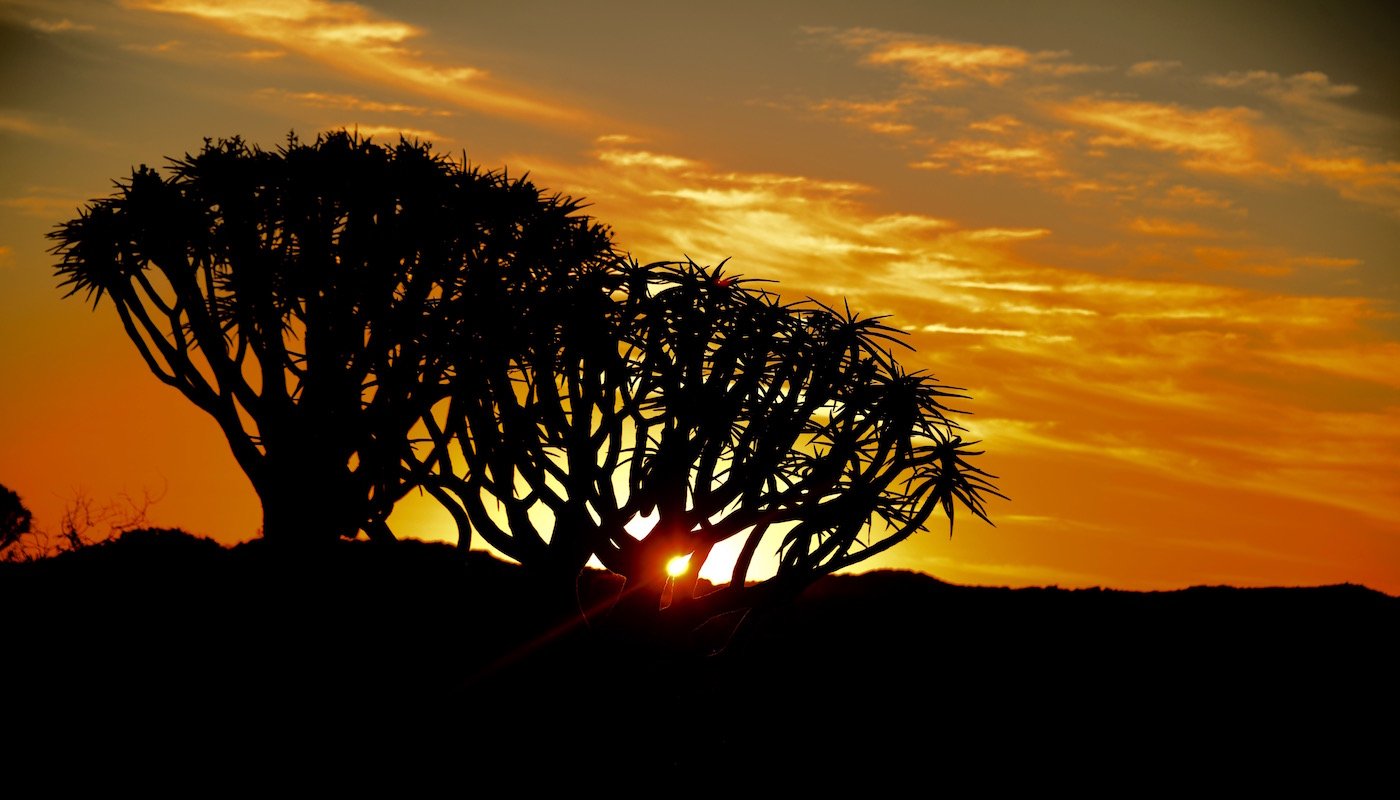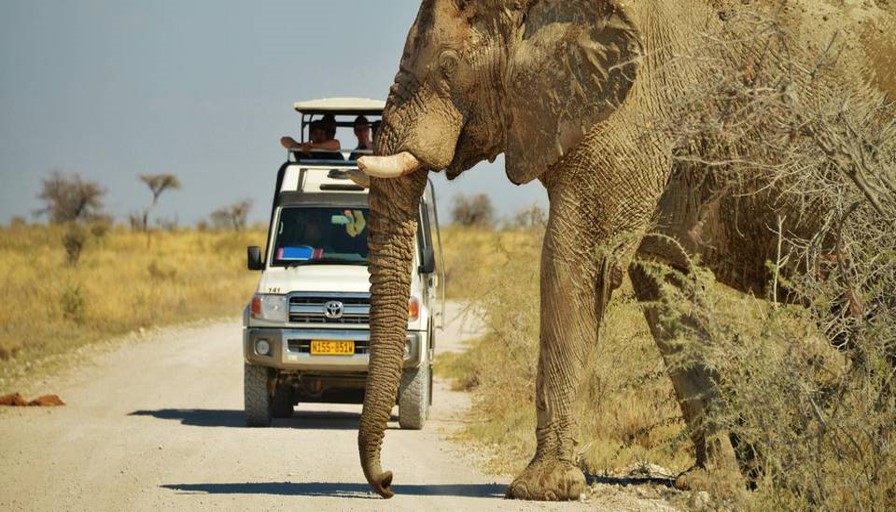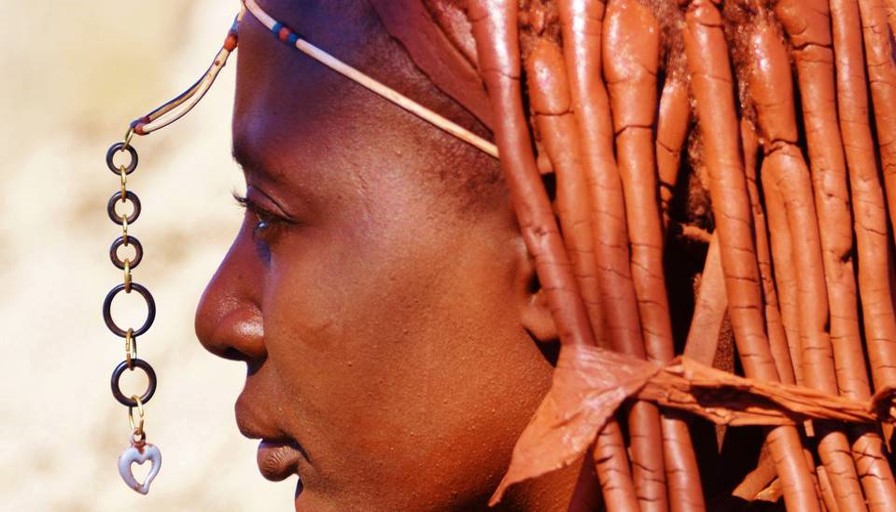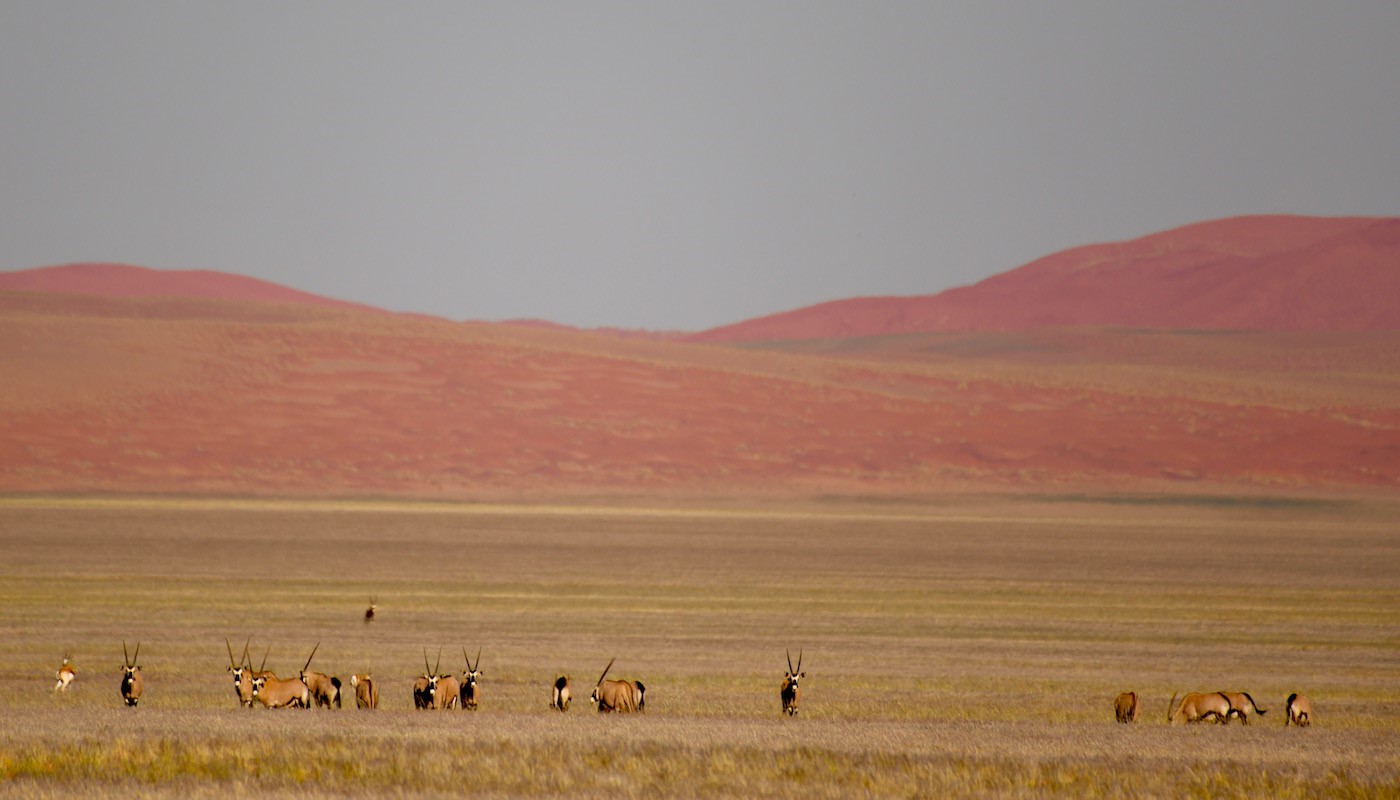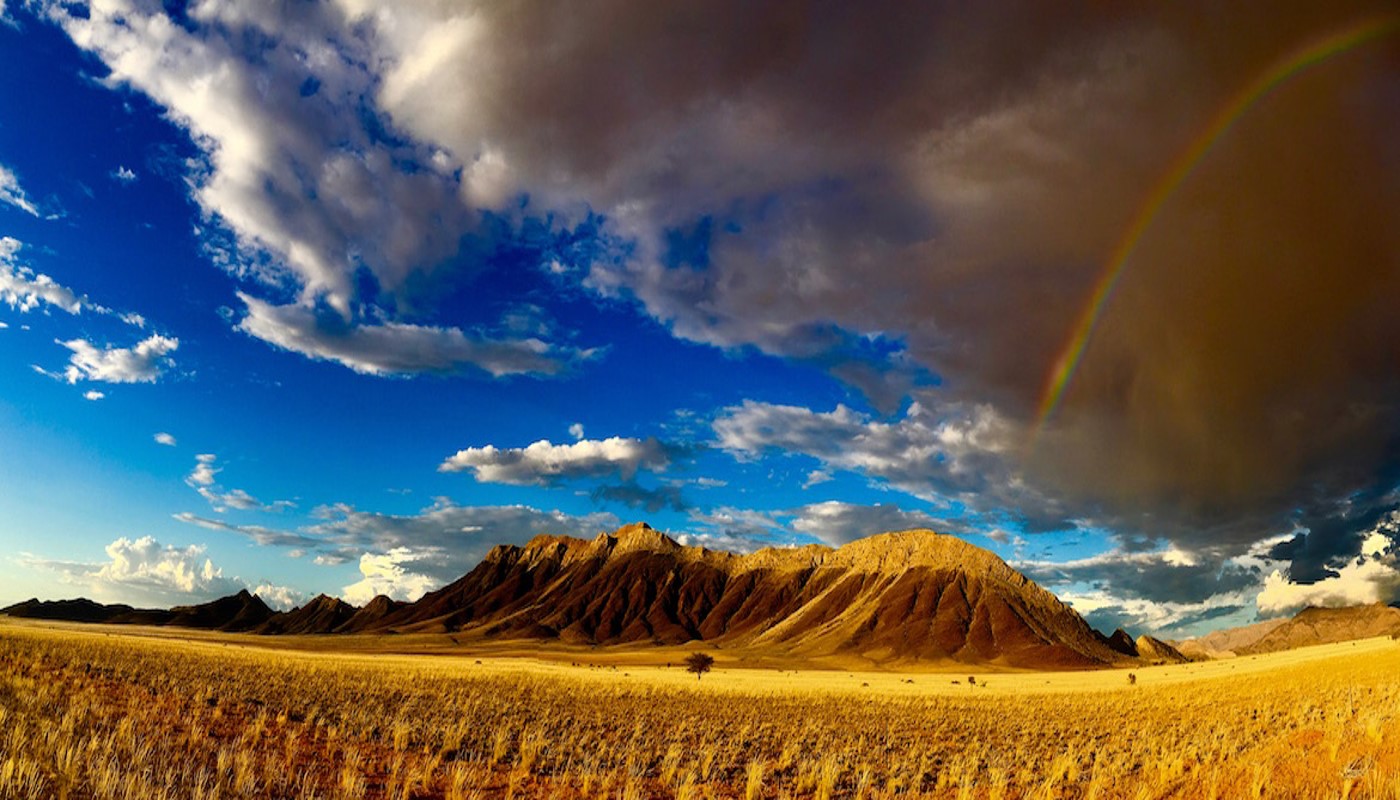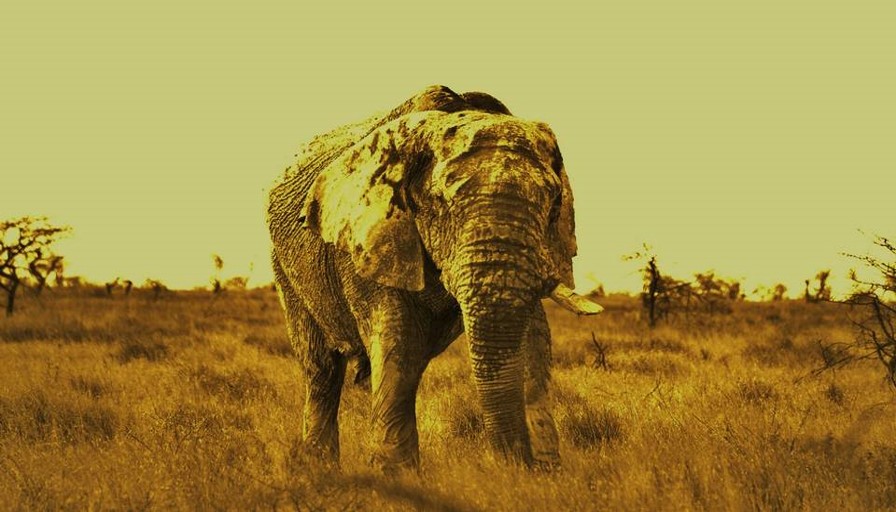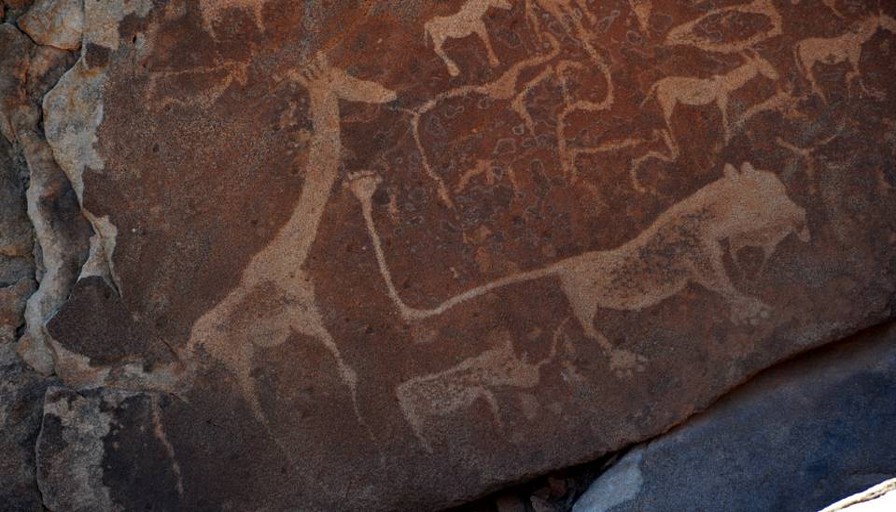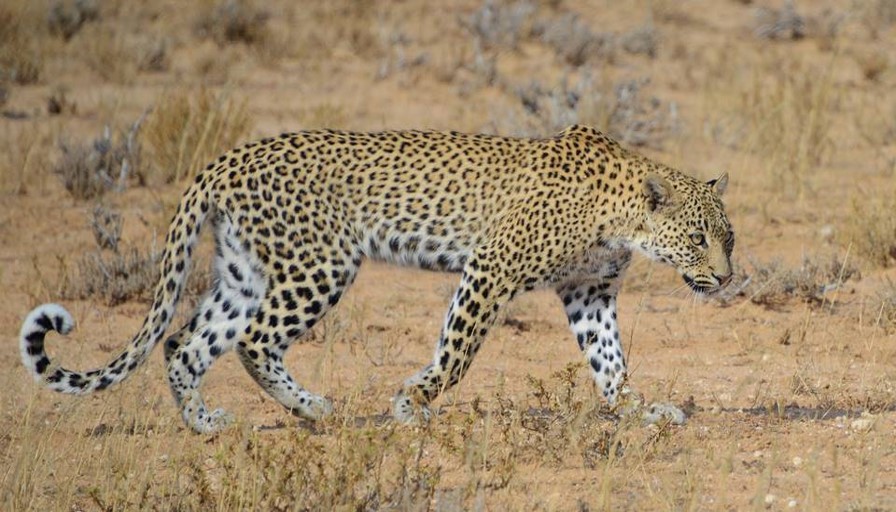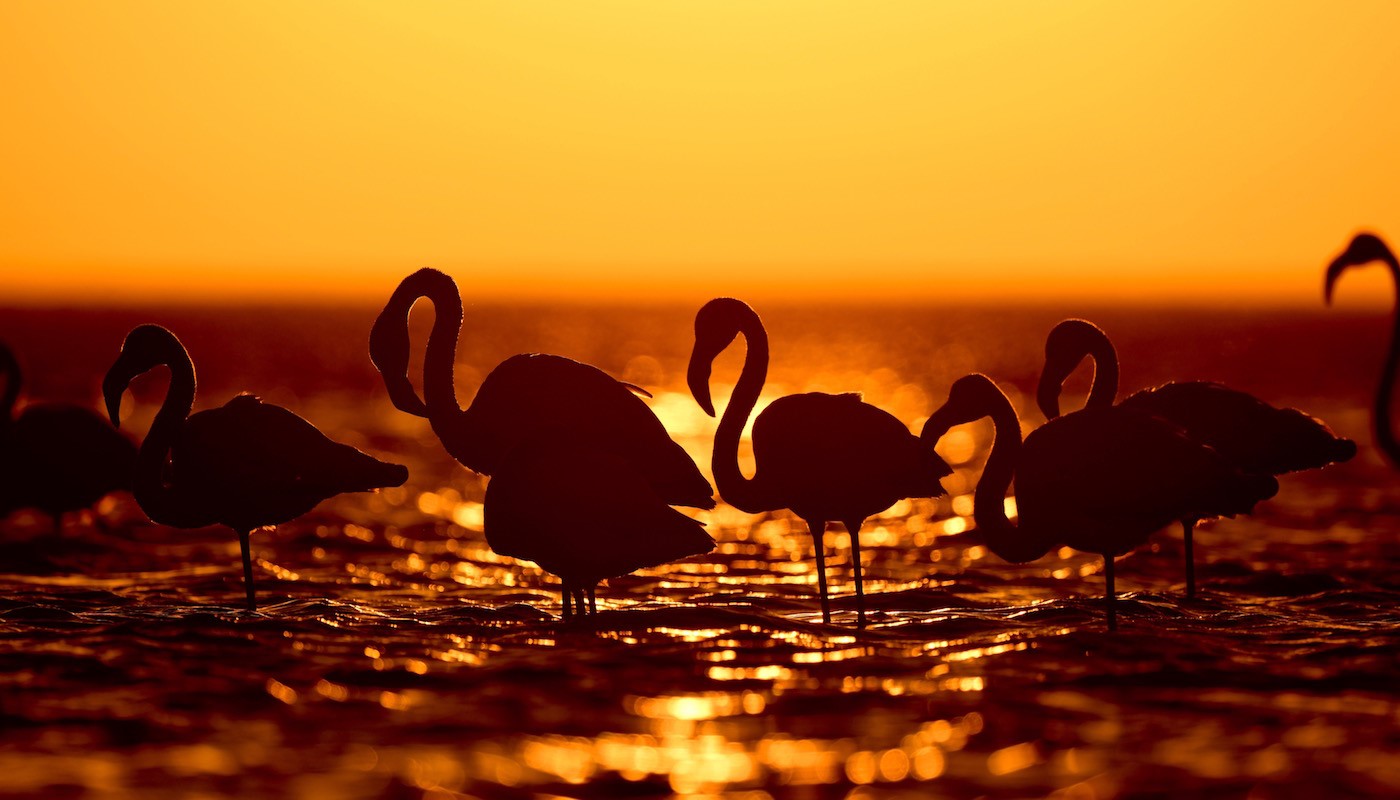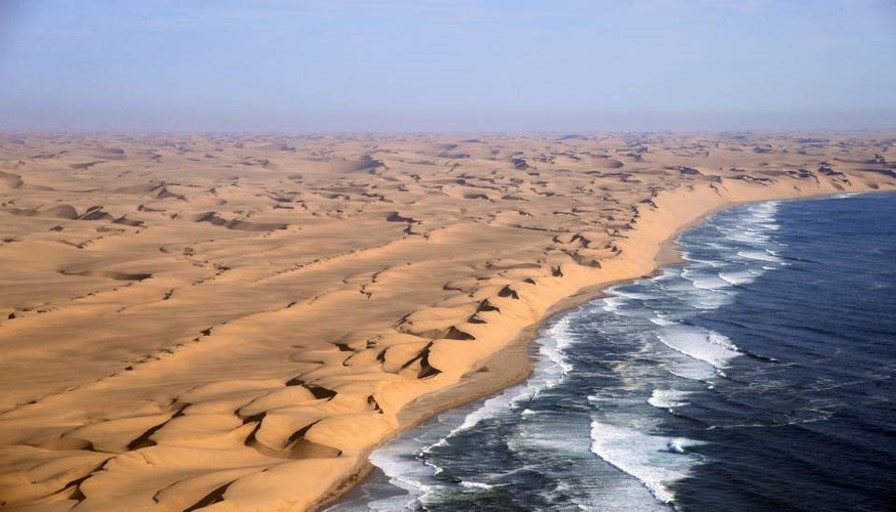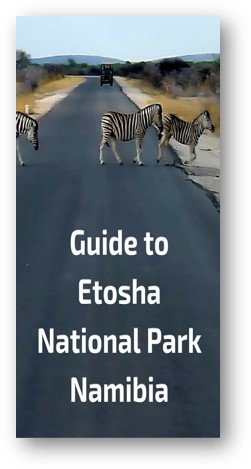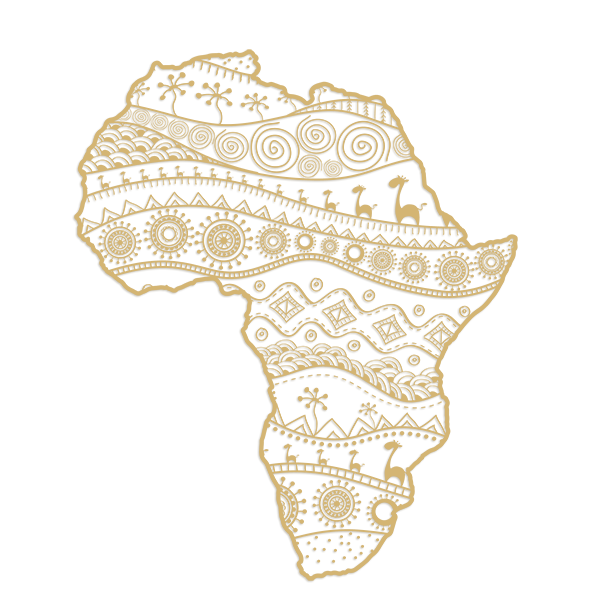
Etosha National Park
Country: Namibia
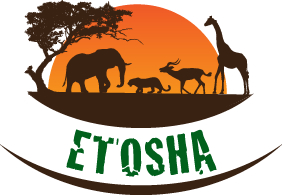
Etosha National Park is a national park in north-western Namibia. The park was proclaimed a game reserve on March 22, 1907 in Ordinance 88 by the Governor of German South West Africa, Dr. Friedrich von Lindequist. It was designated as Wildschutzgebiet Nr. 2 which means Game Reserve Number 2, in numerical order after West Caprivi (Game Reserve No. 1) and preceding Namib Game Reserve (No. 3). In 1958, Game Reserve No. 2 became Etosha Game Park and was elevated to status of National Park in 1967 by an act of parliament of the Republic of South Africa which administered South-West Africa during that time.
Etosha National Park spans an area of 22,270 square kilometres (8,600 sq mi) and gets its name from the large Etosha pan which is almost entirely within the park. The Etosha pan (4,760 square kilometres (1,840 sq mi)) covers 23% of the area of the total area of the Etosha National Park.[2] The park is home to hundreds of species of mammals, birds and reptiles, including several threatened and endangered species such as the black rhinoceros.
The park is located in the Kunene region and shares boundaries with the regions of Oshana, Oshikoto and Otjozondjupa.
ETOSHA NATIONAL PARK is the gateway to Northern Namibia and Ovamboland. It is Namibia’s prime wildlife location and home to a large variety of mammals and birds. Etosha means the ‘ great white area ‘ this refers to large dried pan in the middle of the Etosha Park.
What makes this park unique is the floodlit waterholes at all the main camps. Visit Etosha National Park in Namibia this season and share in Namibia’s wildlife. Etosha park is any photographers dream. Plan your visit to Namibia and experience the great white area of Etosha.
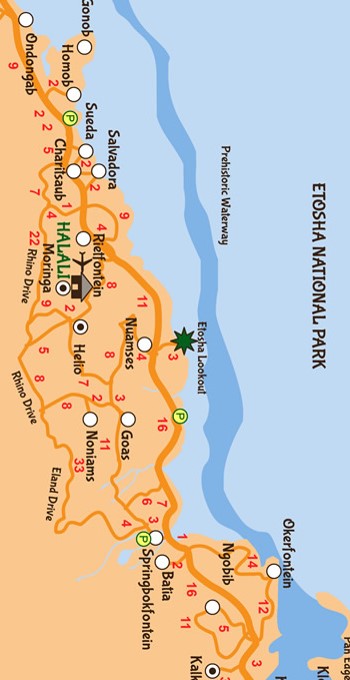
Vital Information
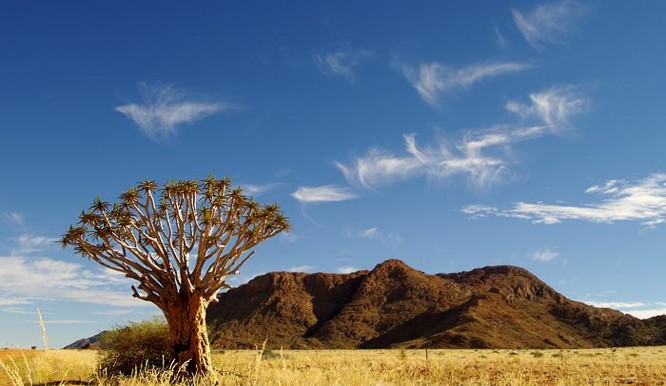
Activities
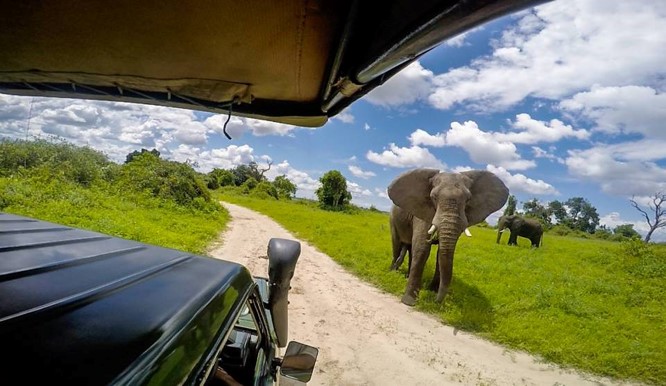
Etosha National Park Gates
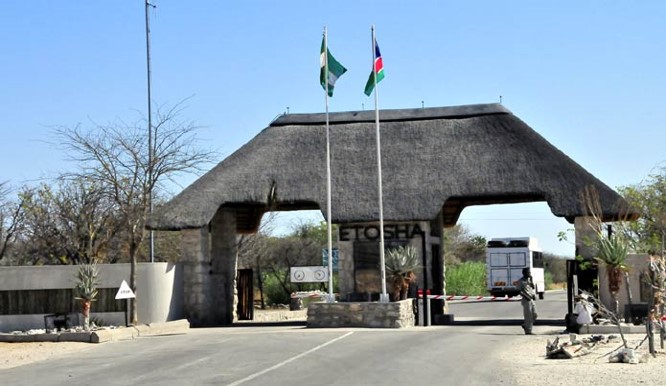
Vital Information
Best Time To Visit Etosha
The best time to visit the park is during the dry season which in Namibia, is during the winter months. This is when many of the animals are concentrated at waterholes and the grass is low, allowing for a better viewing experience.
Winter = Dry Season (May – October) 
During this dry season, many European countries have their summer holidays. Back in Africa, game viewing is at its best in the park making it the best time to visit. You will find an abundance of animals at the water holes as water sources are limited. The pan is often bone dry during this time and the photographic landscape makes for unique pictures. You will need to book well in advance if you are looking to visit during this period as camps are usually fully booked when latecomers arrive.
Summer = Rainy Season (November – April) 
In summer the average temperature during the day ranges from 25C-35C and on really hot days can reach +40C! Etosha is transformed during this season from a dry, dusty- white landscape to a green paradise overflowing with lush vegetation. The birdlife in the summer is intense with many Northern Hemisphere birds migrating south to Etosha. The pan itself gathers water and turns into a lake attracting wetland birds and flamingos. Many of the bigger mammals (such as elephants) will move north towards the Namutoni camp as this area will have more rainfall than down south at Okaukeujo. It is always advisable to ask the rangers for information on where the animals are being spotted during your time at the park.
Average monthly temperature and rainfall
| Month | Precipitation | Temperature |
|---|---|---|
| Jan | 94 mm | 33°C |
| Feb | 107 mm | 31°C |
| Mar | 82 mm | 31°C |
| Apr | 27 mm | 31°C |
| May | 3 mm | 28°C |
| Jun | 1 mm | 26°C |
| Jul | 0 mm | 26°C |
| Aug | 0 mm | 26°C |
| Sep | 2 mm | 33°C |
| Oct | 8 mm | 35°C |
| Nov | 41 mm | 34°C |
| Dec | 51 mm | 34°C |
Etosha Nationalpark Information: Rules & Guidelines
- Guests must report to reception on arrival
- Accommodation is available from 12:00 pm and must be vacated by 10:00 am
- When on game drives, remain in your vehicle at all times
- Obey all the traffic signs in the park
- Only persons with a valid driver’s license can drive in the park
- No one is allowed to remove any wildlife or plants.
The Following is Not Allowed
- Pets are not allowed
- No firearms or projectile- shooting weapons.
- Motorcycles are not allowed
- Please do not feed the wild animals.
- Silence is required around the waterholes and checks to make sure before heading out that waterholes are open for viewing
- Please do not Litter inside the Park.
- No person must leave they’re cars or step outside of their vehicles inside the park leaving your vehicle, unless in designated marked areas in the park.
- No Drones in the Park.
Getting to Etosha National Park
Driving to Etosha from Windhoek
The drive from the international airport in Windhoek to Etosha is around 4 to 4.5 hours, in normal conditions. Many people hire their own cars in Namibia and do a self-drive safari.
Flying to Etosha National Park
Air Namibia offers daily flights from Eros Airport to Ondangwa Airport. Ondangwa is just north of Etosha. The flight is one hour in duration.
These are the airlines that you can find that fly to Etosha National Park. There are currently 16 airlines listed.
International airlines that service towns near Etosha
1time Airline | Low-cost carrier in South Africa. We travel to over 1000 destinations with our flights that are just a click away. 1time Airline (Pty) Ltd was a low cost South African airline that operated for approximately 8 years between the year 2004 and 2012. They are also based in Johannesburg, near O.R Thambo International Airport. The airline only flew Domestic flights around South Africa with many of them being the more famous destinations. |
Air Berlin | Germany’s second largest airline, after Lufthansa. airberlin is one of Europe’s leading airlines. Offering 150 destinations worldwide and award-winning service, airberlin is the first choice for more than 31,7 million travellers. |
Air France | The French flag carrier. Air France, stylized as AIRFRANCE, is the French flag carrier headquartered in Tremblay-en-France,. It is a subsidiary of the Air France-KLM Group and a founding member of the SkyTeam global airline alliance. As of 2013 Air France serves 36 destinations in France and operates worldwide scheduled passenger and cargo services to 168 destinations in 93 countries (including Overseas departments and territories of France. |
Air Namibia | National airline of Namibia. Air Namibia (Pty) Limited is a proprietary limited company incorporated in accordance with the Company’s Act. Air Namibia is the national airline of the Republic of Namibia, with the Government of Namibia as its sole Shareholder. The company’s business operations primarily involve provision of air transport services for passengers and cargo. Through its subsidiary company, Air Namibia Ground Handling (Pty) Limited, it provides ground handling services for passengers and aircraft at Windhoek’s Hosea Kutako International Airport. The airline is positioned as a niche carrier serving domestic points within Namibia, the immediate regional markets of South Africa, Zimbabwe, Angola, Zambia and Botswana. The airline also serves the entire European network through Frankfurt. |
Blue Sky Airways | Botswana’s first high capacity charter and schedule flight service. To ensure maximum passenger comfort, BlueSky operates the Boeing 737-300. The Boeing 737 series boasts as being the best-selling jet airliner in the history of aviation. BlueSky was the first Botswana airline to register a Boeing aircraft. Tried and true; our aircraft are maintained to the highest standards to ensure superior safety and reliability. |
Chapman Freeborn Airchartering
| Chapman Freeborn is Africa’s leading aircraft charter company, with a proven reputation for innovation, expertise and professionalism. Established in 1973, Chapman Freeborn has four decades of experience providing specialised group and VIP passenger charter solutions across the African continent and around the globe. Chapman Freeborn is renowned for arranging dedicated air charter transportation for VIP clients’ unique safari itineraries, often assisting with movements to and from the most remote areas of the continent, always to an exacting standard. With more than 30 locations strategically located across 6 continents, the company’s local – and global – coverage is truly unparalleled. |
Comair | Domestic services in South Africa. An aviation company founded in 1946, Comair Limited is managed and owned by South Africans through its listing on the JSE. For close to 70 years, Comair has provided consistent value, reliability and professionalism. British Airways and kulula.com now carry an average of 4.8 million passengers per annum locally and regionally. Our reputation of quality and passion for service will ensure Comair continues to play a major role in the South African aviation and travel industry. |
Condor | Condor Flugdienst Gmb is a German leisure airline based in Frankfurt. In 1955, Condor, the leisure airline of Thomas Cook AG, is founded on December 21 as “Deutsche Flugdienst GmbH” by four partners, Norddeutscher Lloyd (27.75%), Hamburg-Amerika-Linie (27.75%), Deutsche Lufthansa (26%) and Deutsche Bundesbahn (18.5%). The home airport is Frankfurt am Main. The fleet comprises three British-made, twin-engined Vickers Viking prop jobs, each with 36 seats. Since October 1, 2013, all the companies in the Thomas Cook Group have come together under a single symbol: the Sunny Heart. So the Sunny Heart appears on the tails of the aircraft of Thomas Cook Group Airlines to express their common identity. From October 2013 to summer 2014, the entire Condor longhaul fleet will gradually be fitted with a new cabin, with in-seat entertainment in all classes, and fully-automatic, comfortable reclining seats in the new Condor Business Class. |
Kulula.com | Low-cost services in South Africa and to neighbouring countries. kulula.com is a fun loving and professional airline based in South Africa. Passengers can be assured that every safety precaution is taken before every flight. Passengers can book cheap flights to domestic destinations and more. We also offer affordable hotel accommodation and car hire, making travelling in South Africa easier than it’s ever been. |
Lufthansa | The flag carrier of Germany. The Lufthansa Group is a global aviation group with a total of around 540 subsidiaries and equity investments, which in the financial year 2014 were organised into five operating segments: Passenger Airline Group, Logistics, MRO, Catering and, up to the end of 2014, IT Services. All the segments occupy a leading position in their respective markets. |
Mack Air | MACK AIR is a fixed-wing charter company operating from Maun International Airport in northern Botswana. Our services include: game lodge and camp transfers for tourists. medical evacuations as and when needed. private and business charter. scenic flights over the Okavango. supply runs to and from game lodges. Based in Maun, the gateway to the Okavango, our destinations are throughout Botswana and neighbouring countries reaching as far as Johannesburg, Victoria Falls, Vilanculos and Windhoek. |
Moremi Air | Moremi Air Services (Pty) Ltd, is an air charter company based from Maun in Botswana. The company has been operating since 1997 and has been under new management from June 2003. We have a fleet of 8 different aircraft suited to regional and internationl flying – both single and twin engine, as well as turbine aircraft. We operate from Botswana and into Zambia, South Africa, Namibia and Zimbabwe. Our staff are passionate about their vocations, and are eager to make sure that your journey is part of a memorable safari experience. “Moremi Air – The Journey is the experience” |
SA Airlink | Regional services in South Africa. Choose Airlink to connect you to 35 destinations in 9 African countries. With more than 21 years of of customer focused experience along with the widest network and choice of flights, you get where you want to be, when you want to be there. |
SA Express | Domestic airlines in South Africa. SA Express is a domestic and regional, passenger and cargo carrier established on 24 April 1994. SA Express has since become one of the fastest growing regional airlines in Africa. As a regional airline with route networks covering major local and regional cities, SA Express plays a significant role in the country’s hospitality, travel and tourism industry and is vital contributor to the country’s socio-economic development. The airline’s head office is based at Airways Park in Johannesburg. SA Express has a growing fleet of aircraft and implements self-technical maintenance for all its fleet types at OR Tambo International Airport. An integrated, sustainable regional airline connecting secondary and main airports. |
South African Airways (SAA) | National airline of South Africa. At South African Airways we are the proud national airline of South Africa. We offer great value flights to and from South Africa as well as within our beautiful country. We are committed to the highest standards in everything we do and aim to deliver a world-class experience on every flight. Plan and book your flights with us and experience why we are one of the leading airlines in Africa. |
Swiss | Swiss International Air Lines (SWISS) is the national airline of Switzerland. It serves 106 destinations in 49 countries all over the world from Zurich, Basel and Geneva. With a fleet of 95 aircraft, SWISS transports in the region of 16 million passengers every year. Swiss WorldCargo offers a comprehensive airport-to-airport service for high-quality goods and intensive-care freight to some 120 destinations in more than 80 countries. |
Etosha Park Fees
Entrance fees to be paid at the gate*:
- Adults (foreign) is NAD 80-00 per adult per day
- Adults (SADC) is NAD 60-00 per adult per day
- Adults (Namibian) is NAD 30-00 per adult per day
- Children under 16 years are free of charge
- Vehicles with 10 seats or less are NAD 10-00 per vehicle per day
- Vehicles with 11-25 seats are NAD 40-00 per vehicle per day
- Vehicles with 26-50 seats are NAD 300-00 per vehicle per day
*Fees subject to change without prior notice
Entrance Gates
Etosha National Park is accessible through four gates:
- Anderson’s Gate is on the southern end of the park and can be reached on the C38 via Outjo. The closest camp is
Okaukuejo.
- Von Lindequist Gate lies in the east and connects to the B1. Tsumeb is the closest town to this gate and
Namutoni Camp is only a short drive from the gate.
- Galton Gate lies on the south-western end of the park.
- King Nehale Lya Mpingana Gate is in the northern end of the park and is 48km from the main road to Ondangwa.
Opening Times and Closing Times
The times change weekly and are based on Sunrise and Sunset:
Please Note: When entering Etosha National Park, every visitor has to show proof of identification, either in form of a passport, drivers license or ID due to the poaching incidents.
Tipping is welcomed everywhere, but is expected only in upmarket tourist restaurants, where it’s normal to leave a tip of 10% to 15% of the bill. Some restaurants add a service charge as a matter of course. As a rule, taxi drivers aren’t tipped, but it is customary to give N$2 to N$5 to petrol-station attendants who clean your windows and/or check the oil and water. Note that tipping is officially prohibited in national parks and reserves.
At safari lodges, guides and drivers of safari vehicles will also expect a tip, especially if you’ve spent a number of days in their care.
Most safari companies suggest the following as a rule of thumb:
- guides/drivers – US$10 per person per day
- camp or lodge staff – US$10 per guest per day (usually placed in a communal box)
- transfer drivers and porters – US$3
- A “super zoom” camera with a movie mode feature to capture those once in a lifetime Africa moment
- Binoculars of at around 8 x 30 magnification, as you don’t want to miss that must have safari experience
- A torch (flashlight) is indispensable when you want to find your way back to camp! And a head torch can come in handy, leaving your hands free to carry your photography equipment
- A warm fleece for those cool evenings and early morning safaris
- Neutral colour clothing is a must for game viewers and lots of lightweight breathable cotton tees that you can layer depending on the time of day. Remember to pack light as you’ll have access to a laundry service at Etosha and most other campsites
- A swimsuit and towel as the campsite we use comes with a pool for a refreshing dip
- Sunhat, sunniest and a woolly hat – the latter another early morning “must have”
- Sunblock, lip balm and moisturizing lotion
- A conversion plug to a three pint round pin and all your necessary chargers – they can also be purchased at any airport (if arriving into South Africa or Namibia) or en route on tour
- Traveller’s cheques in US dollars or South African Rands
- Insect repellent and anti-malarial
- Comfortable walking shoes and flip flops
- Beer bottle cooler – perfect for that wildlife fuelled nights at the waterhole
- A quick drying towel
- Think ahead – diarrhoea medication and oral re-hydrate solutions
- First aid kit – all the basic essentials, plus your regular medication
- A waterproof bag to keep your technology safe from the dust
- Wet wipes
- Hand sanitizer
- A guide book, there’s so much to learn when you’re travelling, and Africa is one huge melting pot of wildlife
Waterholes in Etosha
Etosha National Park boasts numerous waterholes, including both natural springs and fountains and others fed by man-made bore holes. Some of the camps in the park offer the unique experience of floodlit waterholes for night-time viewing. Overall, these various waterholes tend to offer the park’s best opportunities for both big and small game sightings, especially during the dry winter months, when more animals are drawn out of hiding to drink at the water’s edge.
However, each waterhole has its own unique personality and the animals that can be spotted at certain waterholes may vary from, even from season to season. Here is a brief overview of the best of the bunch.
Okaukuejo
Okaukuejo Waterhole is right next to the
Okondeka
Okondeka is among the best for lion sightings, and the predators can often be found with kill here. This waterhole is a natural fountain and is situated right on the edge of the west side of the salt pan, a little way North of Okaukuejo.
Halali and Goas
For the shy and elusive leopard, Halali and Goas are probably the best bets, both of which lie roughly mid-way between the southern Andersson Gate and the Von Lindquist Gate on the eastern edge of the pan. The oasis-like natural spring at Goas is also a favourite for
Sueda and Salvadora
The scenic Sueda and Salvadora offer stunning vistas of the pan stretching away to the northern horizon behind them and are also good spots for cheetah sightings. Nearby Rietfontein is one of the larger holes and another regular hang-out for lions.
Tips for good sightings
It’s always worth remembering though that the best waterholes to visit can change on a daily and even hourly basis, and that often it merely comes down to a combination of luck of the draw and patience. Finding a good position, switching off the engine and waiting for something to happen will often yield rewarding results at any of the park’s numerous waterholes. Guides and park and camp staff should be able to give you plenty more information on seasonal variations and on where you might be able to see the broadest certain animals on a particular day or at a particular time. Many of the camps also have a visitors book with a few helpful hints from those who have passed through recently.
Entrance fees to be paid at the gate*:
- Adults (foreign) is NAD 80-00 per adult per day
- Adults (SADC) is NAD 60-00 per adult per day
- Adults (Namibian) is NAD 30-00 per adult per day
- Children under 16 years are free of charge
- Vehicles with 10 seats or less are NAD 10-00 per vehicle per day
- Vehicles with 11-25 seats are NAD 40-00 per vehicle per day
- Vehicles with 26-50 seats are NAD 300-00 per vehicle per day
*Fees subject to change without prior notice
Etosha Nationalpark Information: Travelling Times
Monthly Travel recommendation of The Etosha park.
January, February, March:
These months are typical of rains in the afternoons and animals are giving birth during this season. Animals don’t tend to have to go top watering holes as there is random water all over the park.
April – May:
It is a healthy raining season then the last rains will still fall in April. Sightings along the watering holes are less as the park as natural water scattered all over. April can be exciting as the Springboks and impalas can have a second birth after November rains. Their gestation period is only four months and generally during April, and early maybe one can still see offsprings being born.
June – July – August.
This time is typical winter months, and the park will start to dry up on the naturally scattered water. Winter is when the animals start heading back towards the watering holes. The mornings and the evenings are cold, and sometimes the best sightings are in the middle of the day when it warms up.
Sept – Nov
Spring is rated for the best months of animal sightings as it warms up and the park is arid. Animals tend to gather around the watering holes, and many of the predators have youngins to feed during these times. If the rains are early in November, it is not uncommon to have first offsprings with the impalas and Springboks.
Dec – Jan:
The rains are falling, and the park is starting to show life as the grass turns green. There is an excitement amongst the animals as more grazing is available. The herds are coming together, and these are the times for large crowds and contrast with the backgrounds.
It is not uncommon to see flocks of migrating birds during these times as the rains bring food and the pan regularly fills towards the eastern part near Onkoshi and Namutoni. Allows for possible flamingo’s on their way towards makgadikgadi pans to breed.
Etosha Nationalpark Information: Malaria
Etosha National Park is a low-risk Malaria Region. There have been isolated cases of Malaria in the park, and these only were recorded during the Raining season and people that came from the North of Namibia. As a precautionary matter, we do suggest that you consult your GP on Malaria Prophylaxis when visiting Etosha during Jan – April. The winter temperatures and dry season are not suitable for the mosquitos and in general, there is a high low risk during June – Dec. Most travellers will make use of Malarone tablets.
Etosha is a low-risk Malaria region.
If you are wishing to purchase currency before arriving in Namibia it is easiest to buy Rand as the Namibian Dollar is seldom available in banks outside of Namibia.
To summarize visit Namibia with Rand in your pocket, and make sure you exchange any N$ you have back to Rand before you leave the country.
Credit cards are accepted at most supermarkets, restaurants and accommodation establishments in urban Namibia (Visa and Mastercard are most commonly accepted) but outlets in rural areas are more likely to only accept cash payment.
Credit cards can NOT be used to buy petrol.
Banks can exchange travellers cheques into N$ but this will attract commission, only a few establishments accept travellers cheque, so its best to cash some travellers cheques whenever you find a bank. Larger Namibian Hotels will exchange money, but rates are generally not favourable.
Banks are open from 9am-3.30pm on weekdays and from 9am-11am on Saturdays.
Coins in circulation
- 5 c
- 10 c
- 50 c
- $1
- $5
- $10
Years of mintage are 1993, 1996, 1998, 2000, 2002, 2008, 2009, 2010, 2012, 2015. The cent coins are made of nickel plated steel and the dollar coins of brass.
Banknotes in circulation 
- $10
- $20
- $50
- $100
- $200
Historically, Hendrik Witbooi, once chief of the Namaqua people and instrumental in leading the revolts against German rule at the turn of the 20th century, has been depicted on all Namibian banknotes. However, on 21 March 2012, the Bank of Namibia introduced a new series of banknotes to be issued in May 2012. The new family of banknotes will have the same denomination structure as the current series. All denominations have improved anti-counterfeiting features, and the portrait of Hendrik Witbooi are retained for all but the 10- and 20-dollar notes, which feature a new portrait of Sam Nujoma, the founding president and father of the Namibian nation.
The Bank of Namibia has discovered that the diamond-shaped optically variable ink patch on the N$10 and N$20 notes was cracking after multiple folding and handling. The Bank of Namibia has recently issued in limited quantity, the N$10 and N$20 notes on paper with improved quality and shifted the placement of the diamond-shaped optically variable ink feature.
Activities
Etosha Nationalpark Information: Guided Game Drives
These guided game drives are in customised open vehicles. They all depart and return to the main camps of Etosha.
Game drives on offer at Halali camp, Namutoni Camp, Okaukuejo Camp, Dolomite Camp, Onkoshi Camp.
- Morning drives N$ 650 per person
- Night drives N$ 750 per person
Please book well in advance to ensure availability.
Etosha Park Information: Entry Gates
- Anderson’s Gate is on the southwestern end of the park and is reachable on the C38 from Outjo.
The closest camp is Okaukuejo. - Von Lindequist Gate lies in the east and connects to the B1. Tsumeb is the closest town to this gate.
Namutoni Camp is only a short drive from the gate. - Galton Gate lies on the western end of the park.
- King Nehale Lya Mpingana Gate is at the northern end of the park and is 48 km from the main road to Ondangwa.
- The Park Gates open and close according to the sunrise and sunset times of every month.
- Summer months offer the most extensive window period to enter and exit the park.
Park and Camp Gate Entry and Exit Times
| Months | Sunrise | Sunset |
| January | 06h20 | 19h40 |
| February | 06h40 | 19h30 |
| March | 06h50 | 19h20 |
| April 1 Hour back | 06h00 | 17h50 |
| May | 06h10 | 17h50 |
| June | 06h20 | 17h30 |
| July | 06h30 | 17h30 |
| August | 06h20 | 17h30 |
| September | 07h00 | 18h40 |
| October | 06h30 | 18h50 |
| November | 06h20 | 19h10 |
| December | 06h10 | 19h20 |
Please see our VETERINARY REGULATIONS page here
Plan your visit to Etosha National Park this year.
Contact us online at info@etoshanationalpark.co.za
We can assist with all NWR – Namibian Wildlife Resort Bookings.
Reservations:+264 81 180 0016 / info@etoshanationalpark.co.za
8 am – 5 pm Mon – Friday.
Please send us an email, and we will process your request.
f you love bird-watching, you’ve come to the right place. Etosha National Park is home to more than 340 species of birds, 46 of which are raptors. In summer (November to April) especially, you’ll have no trouble spotting birds of varying colour and rarity, eagles and vultures cruising high in the sky and thousands of flamingos that feed on the algae that gathers in the temporary waters.
Common birds to spot include crimson-breasted shrikes, violet-eared waxbills, northern black korhaans and pale chanting goshawks. Slightly less so are rednecked falcons, whiteheaded vultures and blue cranes among others, and you should feel proud if you spot them. But if you manage to see the following birds, then you should consider yourself incredibly lucky (and be sure to take a photo!):
- Egyptian vulture
- Caspian plover
- White-bellied korhaan
- Black-winged pratincole
- Cape vulture
- Crowned crane
If the bush hasn’t relaxed and rejuvenated your body and mind enough already, why not book a spa treatment? – 4 minutes from Etosha’s east gate – offers visitors a range of massages, holistic treatments, beauty treatments and hot stone therapies. There’s also a gym for those looking to get a bit of a workout whilst enjoying the sights offered by the waterhole right next door.
Please consult these Veterinary Regulations when entering the Park and leaving Etosha Park.
- ANDERSON GATE
- VON LINDEQUIST GATE
- GALTON GATE
As per letter dated 29 May 2007 (download the message here) from the Ministry of Agriculture, Water & Forestry, Directorate of Veterinary Services, please take note of the following valuable information regarding Veterinary Cordon Gates control – in this case, Anderson Gate, Von Lindequist Gate & Galton Gate – Etosha National Park:
1. The following animals / dangerous things MAY NOT under any circumstances be allowed to move southwards through the Veterinary Cordon Fence:
- All cloven-hoofed animals.
Exceptions: sheep and goats in a sealed vehicle, originating from an official veterinary quarantine facility accompanied by a valid red cross permit. (Refer to 2a).Raw meat of animals of cloven-hoofed animals. Exceptions: raw meat in sealed containers from officially approved abattoirs, accompanied by a valid veterinary permit for each consignment. (Refer to 2b) - Raw meat of animals of cloven-hoofed animals. Exceptions: raw meat in sealed containers from officially approved abattoirs, accompanied by a valid veterinary permit for each consignment. (Refer to 2b)
- Raw/fresh milk. (Refer to 3i)
2. The following may cross the Cordon Fence southwards WITH a veterinary permit:
- Sheep and goats in a sealed vehicle, originating from an official veterinary quarantine facility, accompanied by a valid veterinary red cross permit. (Refer to 1a)
- Raw meat in sealed containers from officially approved abattoirs, accompanied by a valid veterinary permit for each consignment. (Refer to 1b).
- Hair, bristle, wool, horns, bone, semen, blood, manure and skin of animals.
- Grass, hay, straw, Lucerne.
- Wild animals without cloven hooves: zebra, rhinoceros, elephant, wild carnivores, etc.
- Bone, bone meal, carcass meal and blood meal.
- Hides and skins which undergone official quarantine.
3. The following may cross the Cordon Fence southwards WITHOUT a veterinary permit:
- Dogs and cats.Horses,
- Horses, donkeys and mules.
- Live poultry and birds, feathers, eggs and raw meat or poultry and birds (unless restrictions are officially announced for the area to avian diseases).
- Fish, reptiles, frogs and worms.
- Wood carvings, mats, baskets, crafts and pottery. Rolls of tobacco, buchu leaves and powder,
- Rolls of tobacco, buchu leaves and dust, firewood.
- Vegetables, fruit, wild fruit, free from manure/blood.
- Leafy vegetables such as cabbage, spinach, lettuce, celery, etc. if free from manure/blood.
- Pot-plants, sedges, palm branches, leaves, vegetable runners, seeds of plants including maize, mahangu, cereals: loose or in containers or bags, provided they are free from manure/blood.
- Used/unused jute bags, lariats (rieme), ropes and meat clothes free from manure/blood.
- Curds (sour milk), whey, butter, margarine and cheese.
- Maximum five litres of boiled milk, or sealed containers of pasteurised milk.
- Cooked travel rations (padkos) – all portions of meat must be prepared and free of blood (Refer to 1b).
Etosha Nationalpark Gates
Etosha Park Information: Entry Gates
- Anderson’s Gate is on the southwestern end of the park and is reachable on the C38 from Outjo.
The closest camp is Okaukuejo. - Von Lindequist Gate lies in the east and connects to the B1. Tsumeb is the closest town to this gate.
Namutoni Camp is only a short drive from the gate. - Galton Gate lies on the western end of the park.
- King Nehale Lya Mpingana Gate is at the northern end of the park and is 48 km from the main road to Ondangwa.
- The Park Gates open and close according to the sunrise and sunset times of every month.
- Summer months offer the most extensive window period to enter and exit the park.
Park and Camp Gate Entry and Exit Times
| Months | Sunrise | Sunset |
| January | 06h20 | 19h40 |
| February | 06h40 | 19h30 |
| March | 06h50 | 19h20 |
| April 1 Hour back | 06h00 | 17h50 |
| May | 06h10 | 17h50 |
| June | 06h20 | 17h30 |
| July | 06h30 | 17h30 |
| August | 06h20 | 17h30 |
| September | 07h00 | 18h40 |
| October | 06h30 | 18h50 |
| November | 06h20 | 19h10 |
| December | 06h10 | 19h20 |
